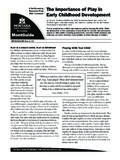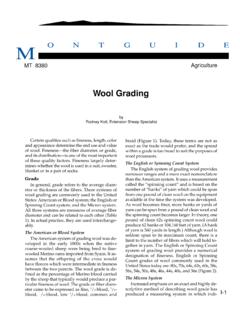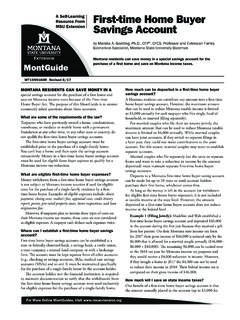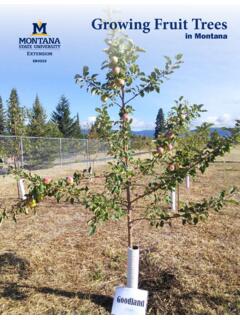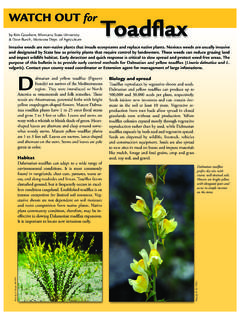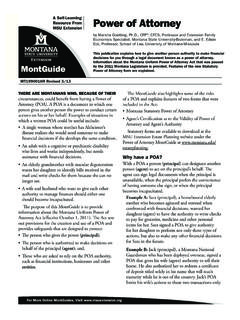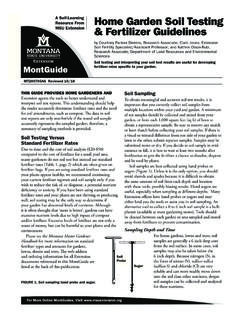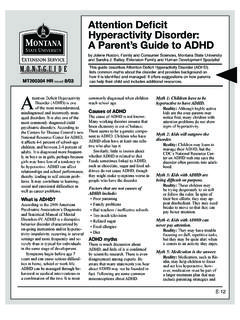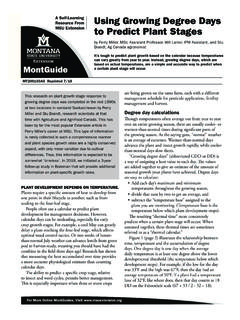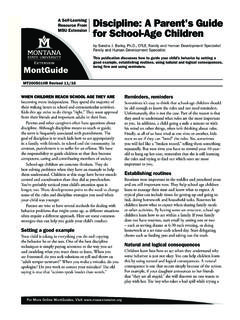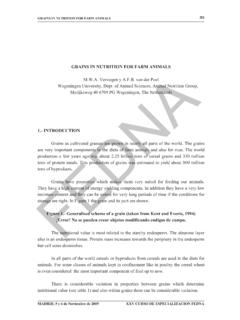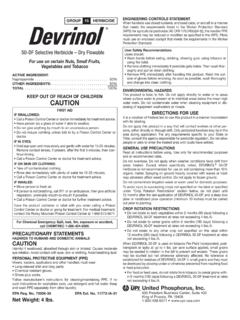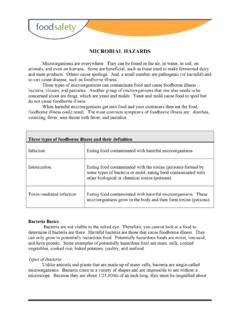Transcription of Small Grain Seed Treatment Guide - MSU Extension
1 Small Grain seed Treatment Guide by Alan Dyer, Associate Professor, Plant Sciences and Plant Pathology; Jeffrey Johnston, Research Assistant; Cecil Tharp, Pesticide Education Specialist, Animal and Range Science; Jessica Rupp, Extension Plant Pathologist; Tyler Lane, Chouteau County Extension Agent; and Jesse Fulbright, Liberty County Extension Agent MontGuide Lists methods for seed treatments to prevent various diseases and pest infestations. MT199608AG Revised 11/17. seed TREATMENTS PROMOTE SEEDLING crop rotations, residue and volunteer management, establishment and help reduce loss of yield and adequate soil fertility (based on water availability), quality due to pathogens and insects. The ability and application of other pesticides are just a few of seed treatments to control fungal diseases has management variables that can influence disease/insect made them a success story of disease prevention.
2 Problems. Careful consideration of all management For instance, smuts and bunts historically caused options available for recurring pest problems is yield and quality reductions in Grain growing regions important. worldwide. The use of effective seed treatments has Before selecting a seed Treatment product, producers reduced the severity of smut and bunt damage to the should determine which diseases and/or insects recur point that their impacts are now minimal. in their location. County Extension agents or the Fungicidal seed treatments control fungi residing Schutter Diagnostic Laboratory (119 Plant Bioscience on the seed surface or inside the seed and are also Building MSU, Bozeman, MT 59717-3150 or http://. effective against pathogens that reside in the soil, ) can aid in identifying pest causing seedling disease and root rot.
3 Most seed problems and provide information for specific areas of treatments do not control bacterial pathogens and the state. Producers can then choose a product based none control seed -borne viruses. Insecticidal seed on comparisons of product activity against organisms treatments have been used for years to prevent seed of concern (see table, page 6). and seedling damage caused by soil-inhabiting insects. It is always important to start with good quality Recently, the development of systemic insecticidal seed . Examine seed lots carefully before purchase or seed treatments with residual activity provides post- when using stored seed . A seed laboratory can conduct emergence protection against insects such as aphids.
4 Standard seed quality tests at a low cost. seed lots with In addition to being one of the least expensive and low test weights, low germination rates, or discolored safest methods of pest control, seed treatments are kernels often produce less vigorous plants, even when generally better targeted and more effective for a this seed is treated. Poor quality seed may be damaged wider range of diseases and insect pests than in the further by seed treatments. seed Treatment dosage past. This publication reports the effectiveness of and environmental conditions affect the ability of available seed treatments on diseases and insects that seed treatments to control target diseases and insects. commonly affect Montana's Small grains.
5 Using recommended application rates and minimizing environmental stresses through good management Guidelines for choosing a seed practices will maximize the benefits of any seed Treatment Treatment . Because some seed treatments may become While seed treatments often are a very important less effective over time, plant seed as soon as possible pest management tool, it is best to develop a long- after it is treated. term plan involving a spectrum of pest management practices. seed treatments, resistant varieties, For More Online MontGuides, Visit Fungal Disease Control seed Treatment for this disease and as such, is highly Diseases controlled by seed treatments are categorized recommended for anyone producing winter wheat in into three primary groups: the smuts and bunts, the Montana.
6 Difenoconazole provides nearly complete seed and seedling diseases, and the root rots. In the control of dwarf bunt when used at the highest case of smuts and bunts, seed treatments provide recommended rate. While genetic resistance to this very effective control against a potentially devastating disease is available, many, if not most, varieties of group of diseases. Although seed treatments have winter wheat grown in Montana are not resistant. effectively controlled smuts for the last 40 years, these Covered smut of barley Covered smut (Ustilago diseases are still present in Montana and growers hordei) differs visibly from loose smut in that a mass should take this risk seriously. For seed and seedling of black spores develops within a semi persistent diseases, seed treatments are an indispensable control membrane in place of the kernels.
7 Harvest of infected tool whose effectiveness can be greatly enhanced Grain with healthy Grain results both in yield and through proper planting practices. Typically, a seed quality losses. Use of effective seed treatments can Treatment will protect seedlings for two to three weeks. prevent yield losses due to covered smut. Covered smut Historically, root rots have been less affected by seed can be soilborne, but is more commonly seedborne. treatments than other disease groups. However, some The fungal spores reside directly on the seed surface or newer formulations are making significant strides in under the hull of the barley kernel. Most surface-acting controlling root rot diseases. In some instances, these seed treatments result in elimination of spores on the seed treatments may provide good root rot control by seed surface.
8 Themselves, but one should not rely solely on them for disease management. Instead, seed treatments should be Loose smut of wheat and loose smut of barley integrated with plant resistance and cultural practices to Although loose smut of wheat (Ustilago tritici) and provide effective management of root rots. barley (Ustilago nuda) is caused by two different pathogens, these organisms act in a similar manner Smuts and bunts on both crops. Spikelets on infected plants normally Common bunt of wheat Common bunt is caused become transformed into a dry mass of dark spores by Tilletia tritici (formerly known as T. caries), and T. enclosed in a delicate membrane. This membrane laevis, (formerly known as T. foetida). Common bunt ruptures easily and the spores blow away, leaving only a is also known as stinking smut because its presence barren head stalk (naked rachis).
9 The windblown spores on the head causes a pronounced odor of dead fish. enter the flowers of developing heads. Both pathogens The disease may affect spring and winter wheats but then invade the seed germ or embryo, leaving one with is most common in late-planted winter wheat. Several infected seed . Because the fungus resides inside the seed treatments are highly effective against this disease infected seed , protective fungicides that only provide and have made what was once a very common disease, control on the surface of the plant are ineffective for relatively rare. Despite the disease's rarity, the fungus control of loose smuts. is present within the state and on occasion causes In contrast to loose smut of wheat, which is a fairly substantial losses in unprotected fields.
10 Rare disease in Montana, loose smut of barley is fairly Dwarf bunt Dwarf bunt (Tilletia controversa, Kuhns), common. Therefore, Treatment of barley seed with also referred to as TCK, only affects winter-sown an effective systemic fungicide is recommended. It cereals. Like common bunt, dwarf bunt reduces is important to note that Difenoconazole provides yield and Grain quality through the production of an effective control for loose smut of wheat, but is unpleasant odor and taste in infested Grain . Dwarf ineffective for loose smut of barley. If Grain is to be bunt can only develop where snow exists for prolonged saved for seed from loose smut infested fields, that periods on unfrozen ground and occurs in scattered seed should be treated with an appropriate systemic areas of western and central Montana.
